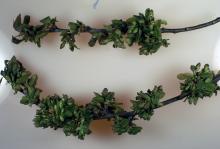Cause This problem is apparently related to low levels of boron in early spring. A virus was implicated but never found.
Symptoms Poor growth and off-color generally show in time when affected trees or branches have smaller unopened green buds on shorter stems. Eventually, blossom buds open but soon abscise at the pedicel base, leaving a ring of persistent green bud scales.
As new leaves form, they are narrow, delayed in expanding, and form a cluster of small leaves due to the slow elongation of the terminal growth. As terminals grow, trees appear more normal, but severely affected branches or trees will show long, narrow, or short-cupped leaves as well as normal leaves.
Chemical control Rosette can be reduced or cured by bringing the boron level into a normal range for cherry. Apply to leaves in September.
- Borasol at 2 to 4 quarts/A.
- Solubor at 5 to 8 lb/A.
Note Reports indicate that sodium pentaborate in the form of Solubor is compatible with wettable-powder formulations of captan, diazinon, malathion, Sevin, wettable sulfur, and urea. Boron, however, reacts with water-soluble packets, in which some pesticides are sold, to form an insoluble goo that can clog a sprayer.
Reference Bolwyn, B. 1967. Relation of boron to cherry rosette disease in Oregon, and the possible implication in Oregon, and the possible implication of a virus. PhD thesis, OSU, Corvallis, OR.


